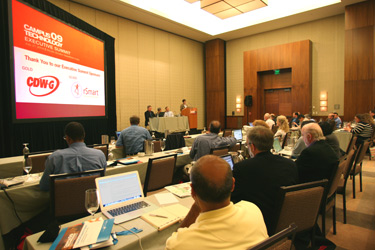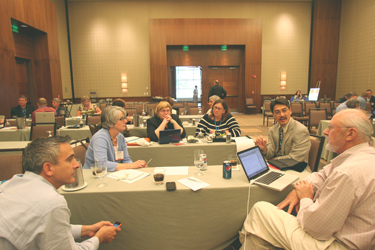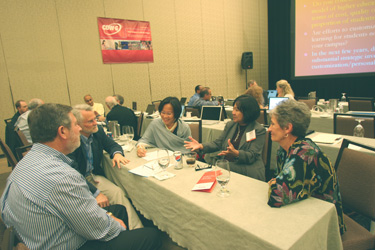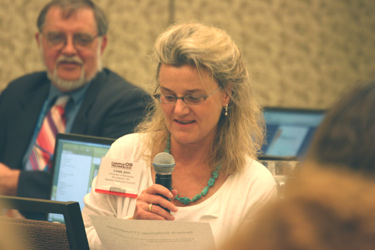Have We Reached an IT Dead End?
As the Executive Summit moved into its afternoon sessions, discussion about IT innovation in teaching and learning seemed to run into brick walls each way it went to the point where one person in the audience asked “Will higher education just be replaced?” Or, as another panelist asked, “Can the traditional institutions compete with the commercial institutions?”

For a couple of decades, technologists within higher education have assumed that if the technology could be made available, and was supported, that that was the first step toward educational revolution. Innovation was equated with use of technology. Now that we see for how small a fraction of faculty this was true, the general sense was that all of higher education is taking a deep breath and reconsidering all premises. [Photo above shows the afternoon plenary session on leadership, with panelists Wayne Brown, Excelsior College; Anne Moore, Virginia Tech; Chris Copolla, rSmart; and Joan Getman, Cornell University moderating. Photos below show the afternoon discussion session, led by Chris Dede, Harvard University.]
Have the Good Times Just Ended?
Will we always have CIOs or VPs of IT? Or were these titles just an anomaly while technology seemed new and confusing? Is there really a danger to the enterprise if learning innovation does not occur on a broad scale? Is it safest to just keep the machines running and the wires humming? Do we have any idea of the change we would like to see? One panelist reported results from a study of CIOs that indicated that CIOs are perceived as doing the best job if they just keep everything running, as a utility is supposed to do. They were perceived as least successful in planning. Therefore, the question becomes: Why should a CIO be on a president’s
cabinet? The answer, according to the survey, is they are no more effective on the cabinet than off.

Perhaps our questions were too macro for a one-day meeting. Or maybe they were just right and the resulting conversation is just what higher education should recognize and then consider: Has all the expenditure on IT resulted in innovation at the core? Should we look to innovate? And, if so, where do we find the innovation and who should build on it and lead toward ongoing innovation?
Why Not Look Even Beyond the Edges?
The answer about where to find innovation, unexpectedly, may be, as one panelist suggested, that parents are leading innovation by setting the example at home and providing the means for their children to strike out and experiment. She suggested that we may start to see more “free agent students” who create their own ala carte learning path, learning more and more from peers and from experiences.

In this confusing situation where the CIO, who took the job because she or he liked technology, ends up doing all kinds of work that’s not related to technology, one bright energy center can be adoption of open source software, another edge. According to one panelist, some open source communities generate broad-based local campus communities where people across campus boundaries talk to each other on a regular basis. This is particularly true on campuses that actively contribute code to the reference instance.
On another edge, we find offices on campus that have been organizing alternate forms of learning for decades. Staff in these offices started with alternate--experiential--learning opportunities years ago so technology does not now tilt their playing field. Instead, offices supporting service learning, internships, the year abroad, the gap year, co-op learning, and so on, easily welcome Web 2.0 technologies as management tools for their approach to learning. Indeed, it would not be surprising to see the alternate learning approaches become the dominant ones not too far in the future. For those wondering where the innovation is on campus, it’s been there all along in offices that have been undervalued and perhaps perceived as offering students only “icing on the cake.”

The Key Role of ePortfolios
And the tool for these “alternate” forms? ePortfolios, as another panelist contended. If students are “free agents,” involved in experiential learning experiences, working in teams, working in authentic situations that present evaluation challenges to faculty, perhaps an ePortfolio that contains evidence of the learning for later review is necessary.
We are too much stuck by our current arrangements: test-based evaluation and class scheduling (seat time). Learning is least effective as an assembly line experience, which calls into question the assembly line means by which higher education institutions have monetized learning. Freeing us from the assembly line grid would allow us to innovate. Electronic portfolios are another way to organize learning experience and therefore allow learning to be more mobile and varied. Using ePortfolios in this way is what the panelist called not “teacher-centered,” nor “learner-centered,” but “learning-centered.”

One participant described how her university had an annual Tech Day Conference where substantial awards are given to faculty who use technology in imaginative ways: a salary increase for one year. This is rewarding the messiness of innovation instead of penalizing it as is usually the case.
As the moderator pointed out, higher education has realized that after all the technology initiatives and implementations we are now face-to-face with the real challenge: people. We can sort of predict technology changes, but predictions about what people will do with technology almost always are off the mark. We have brought in the machines and wires and software but the human element will adapt in its own way.

We’ve Done the Machines; Now to Start the Real Work
The afternoon discussion session leader called traditional classroom practice “schooling,” and said it is structurally wrong and cannot be made to work. “There is no single one best way to learn. Better to present an ecology of learning and let the students select from the ecology." [Discussion sessions pictured in the five images above, with Chris Dede shown leading in the first of five.]
About the Author
Trent Batson is the president and CEO of AAEEBL (http://www.aaeebl.org), serving on behalf of the global electronic portfolio community. He was a tenured English professor before moving to information technology administration in the mid-1980s. Batson has been among the leaders in the field of educational technology for 25 years, the last 10 as an electronic portfolio expert and leader. He has worked at 7 universities but is now full-time president and CEO of AAEEBL. Batson’s ePortfolio: http://trentbatsoneportfolio.wordpress.com/ E-mail: [email protected]